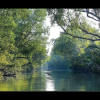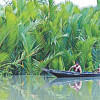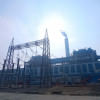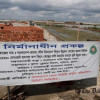Shift it 10km away

Sundarbans, a magnificent and unique ecosystem of the world, faces an existential question today with a coal power plant to be set up at Rampal. It has been a content of discord between environmentalists and those who are pushing the plant. Both sides are giving out their own arguments in favour of and against the plant to be set up within 14km of the mangrove forest. The Daily Star wants to bring to the public the arguments and the counterarguments that the protagonists and antagonists of the plant have to make. Today we publish an interview of Dr Badrul Imam, professor at the Department of Geology, Dhaka University. Akram Hosen and Tuhin Shubhra Adhikary took the interview.
The Daily Star (TDS): How would you respond to the PM's speech on the Rampal power plant?
Imam: I thank the prime minister for talking about Rampal power plant. I believe this topic should best be looked at from a scientific perspective. The focus of the argument should be the biological, chemical, and physical impacts of a coal-fired power plant on a highly sensitive ecological system like the Sundarbans. I do not mind arguing with an opposing view as long as the arguments are scientifically honest and factual. My stand on Rampal is purely non-political. I feel that Khaleda Zia tried to play politics with Rampal and the prime minister's speech is mostly a response to that.
TDS: What do you think of the prime minister calling the anti-Rampal movement as anti- development?
Imam: I would like to make it clear that we are not opposing the development programmes of the present government; rather we support the way the prime minister is moving forward with a massive power generation programme, much of which is coal-based. The apprehension that a large coal-based power plant very close to the Sundarbans would have serious negative impact on the environment motivates us to campaign against the Rampal coal power plant. No way is this a campaign against the government. On the contrary, we believe we are trying to protect the image of the prime minister in the long run from any blame in the aftermath of any unfortunate scenario of a damaged Sundarbans.
TDS: Why are you raising concerns over possible environmental damages even after an Environmental Impact Assessment (EIA) has been done and the authorities have already given the go-ahead?
Imam: The environmental clearance process was done in a wrong way. They selected a site, acquired the land and then, a year later, conducted an EIA that was approved without any question. The point of conducting an EIA is lost here. The EIA should have been conducted first. If it found that the site was suitable for the project, the authorities should have acquired the land.
Moreover, the EIA was done by the Centre for Environmental and Geographic Information Services, an organisation operating under the Ministry of Water Resources, not an independent one free from any government influence. It appears as though the EIA was just eyewash.
TDS: When the authorities are saying that they will use state-of-the-art technology to prevent pollution and the plant will not hurt the Sundarbans, why are you opposing it?
Imam: They have been saying that they would use Super Critical Technology (SCT) at Rampal as indicated in the EIA (July 2013) and official handouts and flyers (2016). When it was pointed out that the use of SCT will not reduce the emission to expected level for the Sundarbans, proponents of Rampal began to claim they would use Ultra Super Critical Technology (USCT) and there will be no environmental pollution.
USCT efficiency can be around 40-45 percent and the world class top technology being developed and used is Advanced USCT that has an efficiency of 45-52 percent. No matter how modern the technology, the emission reduction in coal-fired power plant is partial. Contamination will be lesser if you use AUSCT instead of USCT or SCT, but there will still be contamination. So a coal-fired power plant with “zero contamination” does not exist. A partial reduction of emission for any other area may be ok but for an ecologically sensitive area like the Sundarbans, it is not.
TDS: The authorities have assured that the coal ash generated from the plant would be used by different cement factories and brick kilns. So why are you still concerned about disposal of the ash?
Imam: By burning coal, the power plant will annually generate 10 lakh tonnes of ash for the next 30 years. Besides, the government is going to set up five other coal-fired power plants of similar capacity (1320mw) in Matarbari, Payra and Maheshkhali. So, similar amount of coal ash will be generated from each of those plants. Will there be a steady demand for such a huge amount of ash for 30 years? No. It is highly likely the power plants will compete with each other to sell the ash, one plant offering lower prices than the other. It is also likely that the cement manufacturers or brick kiln owners would prefer whichever plant is nearer to their set-ups.
As per the EIA report, the ash would be initially stored in a 100 acre pond. Responding to concerns over keeping this large amount of ash near the Passur river, the authorities are now claiming that the pond would be on 25 acres. Having an ash pond beside the Passur river is courting disaster. The concern is that if the pond were flooded, the ash containing heavy metals such as lead, mercury, arsenic, chromium, and cadmium that are hazardous to human health and to wildlife, would spread throughout nearby areas and jeopardise the flora and fauna of the Sundarbans. Besides, groundwater would be contaminated if the heavy metals in the ash leach into groundwater due to any damage in the pond's lining.
Moreover, as per the EIA report, a big area of the plant will be filled up by fly ash which will be environmentally damaging for both groundwater and soil.
TDS: You also talk about possible water pollution. Why?
Imam: Over 10,000 tonnes of coal will be transported by lighter vessels plying the Passur through the Sundarbans every day. Will there be no spillage over a span of 30 years (average lifespan of a coal-based plant of such capacity)? How is it possible to load and unload vessels without some spillage in the context of Bangladesh?
Moreover, coal-fired power plants need a lot of cold water for the boilers. This plant will use 9,000 cubic meters of water per hour and discharge 5,000 cubic meters of it per hour into the river. If untreated, the water will be highly contaminated and hot.
They are claiming that the water will be treated and cooled down before release. But the question is who will check the discharged water for toxicity and temperature over 30 years in the Sundarbans? Have we been able to ensure that the industries near the capital do not discharge untreated effluent into the rivers? Do we have any examples before us to trust such claims?
On top of everything, sucking in and discharging huge amounts of water from the river for 30 years will severely disturb marine lives.
TDS: Are you not convinced of the measures taken to control emissions of toxic chemical compounds?
Imam: The authorities have recently started claiming that they will use Flue Gas Desulfurization (FGD) scrubber to prevent emission of sulphur dioxide and nitrogen oxide. But the problem remains after the scrubber captures sulphur dioxide. For example, this is a wet solid residue -- an off-white slurry with fly ash in it. The point is, what will they do with this captured residue? Releasing it into water will contaminate the water. If they bury it, the soil will be contaminated. This problem is not unique to Bangladesh, but is a worldwide problem in coal-fired plants even with upscale technologies. You can see the report in the New York Times describing how people in New Jersey lament the FGD technology which, they say, cleans the air at the expense of water pollution.

TDS: Since you point out so many environmental costs of coal-fired plants, are you against coal in general?
Imam: No. You can't probably banish coal in Bangladesh at the moment as there is not enough gas here. Coal is heavily used in India, China, Australia, and the United States. There is no problem with coal to be used in other plants on the cards. But we are talking about a very sensitive ecological world heritage site here -- the Sundarbans. If you destroy it once, you will never be able to get it back. You can't create another Sundarbans.
TDS: Given the densely populated nature of the country, people would still be affected if it were moved somewhere else.
Imam: When the government acquires a land, the people are compensated for their loss. Some negotiations and compensations are inevitable. It's necessary for development. Producing electricity comes at the expense of something else. But the Sundarbans is not negotiable.
Some people don't seem to understand science. It's a very ecologically diverse place. The smallest forms of lives and organisms are interconnected to the bigger ones. If you destroy plankton, the fish will be affected; eventually the tigers would also be affected. Professor Rajvender Jhala of Wild life Institute of India pointed this out in his research report published recently and claimed that Rampal will damage the Sundarbans.
TDS: Wouldn't scrapping Rampal undermine the government's power generation goal?
Imam: By 2021, the government aims to achieve a generation capacity of 24,000 megawatts of electricity. What difference does it make if you don't have the 1,320 megawatts from Rampal? If Rampal power plant goes into operation, each person of the country, on average, will get about eight watts of electricity, which is too little to light a small bulb. It is not that development will be seriously hampered without this power plant. Yet, we are not asking to scrap it, but to relocate it to a safe distance from the Sundarbans.
TDS: Can you suggest an alternative site for the power plant?
Imam: The authorities can shift the plant to Labanchhara, which is 10 kilometre north of Rampal. The EIA report also mentioned Labanchhara alongside Rampal as a possible site. Labanchhara is about 24 kilometres from the Sundarbans. Also, the coal can be transported through Mongla-Ghashiakhali channel instead of the Passur river, thus bypassing the Sundarbans. I think the plant would be reasonably acceptable if it were set up at Labanchhara and the coal transport would avoid a route through the Sundarbans.
(Dr. Badrul Imam earned his doctoral degree from London University. He also taught at universities in Canada and Saudi Arabia for several years. He has worked and wrote extensively on issues related to problems and prospects of energy resources in Bangladesh. He was a member of the national committee for formulation of coal policy and worked in the national evaluation committee of Asia Energy proposal for Phulbari open pit coal mining. He is active with the National Committee to Protect Sundarbans.)

 For all latest news, follow The Daily Star's Google News channel.
For all latest news, follow The Daily Star's Google News channel. 








Comments